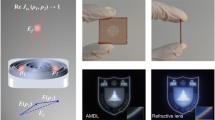Abstract
DURING the past summer, in the Transactions of the Optical Society, Mr. J. W. Gifford has directed attention anew to the question as to the two wave-lengths most suitable for achromatising telescope objectives. Mr. Gifford has constructed telescopes in which the paraxial focal length for the D and E lines is the same, and, judging by the performance of such objectives, he considers such a choice superior to the more customary choice of the C and F lines. By a different path I have been led to a similar judgment, at least for telescopes of large aperture.
This is a preview of subscription content, access via your institution
Access options
Subscribe to this journal
Receive 51 print issues and online access
$199.00 per year
only $3.90 per issue
Buy this article
- Purchase on SpringerLink
- Instant access to full article PDF
Prices may be subject to local taxes which are calculated during checkout
Similar content being viewed by others
Author information
Authors and Affiliations
Rights and permissions
About this article
Cite this article
SMITH, T. The Choice of Wave-lengths for Achromatism in Telescopes. Nature 114, 536 (1924). https://doi.org/10.1038/114536a0
Issue date:
DOI: https://doi.org/10.1038/114536a0



